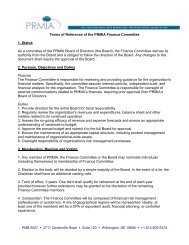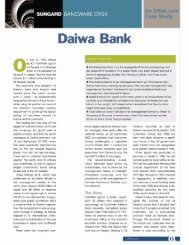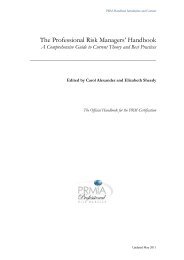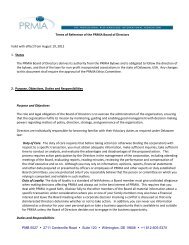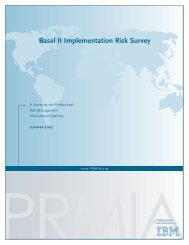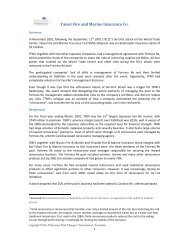WorldCom Case Study1 - PRMIA
WorldCom Case Study1 - PRMIA
WorldCom Case Study1 - PRMIA
Create successful ePaper yourself
Turn your PDF publications into a flip-book with our unique Google optimized e-Paper software.
the second-largest long distance telephone company in the United States and one of<br />
the largest companies handling worldwide Internet data traffic. 9 According to the<br />
<strong>WorldCom</strong> Web site, at its high point, the company<br />
• Provided mission-critical communications services for tens of thousands of<br />
businesses around the world<br />
• Carried more international voice traffic than any other company<br />
• Carried a significant amount of the world's Internet traffic<br />
• Owned and operated a global IP (Internet Protocol) backbone that provided<br />
connectivity in more than 2,600 cities and in more than 100 countries<br />
• Owned and operated 75 data centers on five continents. [Data centers provide<br />
hosting and allocation services to businesses for their mission-critical business<br />
computer applications.] 10<br />
<strong>WorldCom</strong> achieved its position as a significant player in the telecommunications<br />
industry through the successful completion of 65 acquisitions. 11 Between 1991 and<br />
1997, <strong>WorldCom</strong> spent almost $60 billion in the acquisition of many of these<br />
companies and accumulated $41 billion in debt. 12 Two of these acquisitions were<br />
particularly significant. The MFS Communications acquisition enabled <strong>WorldCom</strong> to<br />
obtain UUNet, a major supplier of Internet services to business, and MCI<br />
Communications gave <strong>WorldCom</strong> one of the largest providers of business and<br />
consumer telephone service. By 1997, <strong>WorldCom</strong>'s stock had risen from pennies per<br />
share to over $60 a share. 13 Through what appeared to be a prescient and successful<br />
business strategy at the height of the Internet boom, <strong>WorldCom</strong> became a darling of<br />
Wall Street. In the heady days of the technology bubble Wall Street took notice of<br />
<strong>WorldCom</strong> and its then visionary CEO, Bernie Ebbers. This was a company "on the<br />
move," and Wall Street investment banks, analysts and brokers began to discover<br />
<strong>WorldCom</strong>'s value and make "strong buy recommendations" to investors.<br />
As this process began to unfold, the analysts' recommendations, coupled with the<br />
continued rise of the stock market, made <strong>WorldCom</strong> stock desirable, and the market's<br />
view of the stock was that it could only go up. As the stock value went up, it was easier<br />
for <strong>WorldCom</strong> to use stock as the vehicle to continue to purchase additional companies.<br />
The acquisition of MFS Communications and MCI Communications were, perhaps, the<br />
most significant in the long list of <strong>WorldCom</strong> acquisitions. With the acquisition of MFS<br />
Communications and its UUNet unit, "<strong>WorldCom</strong> (s)uddenly had an investment story to<br />
offer about the value of combining long distance, local service and data<br />
communications." 14 In late 1997, British Telecommunications Corporation made a $19<br />
billion bid for MCI. Very quickly, Ebbers made a counter offer of $30 billion in<br />
<strong>WorldCom</strong> stock. In addition, Ebbers agreed to assume $5 billion in MCI debt, making<br />
the deal $35 billion or 1.8 times the value of the British Telecom offer. MCI took<br />
<strong>WorldCom</strong>'s offer making <strong>WorldCom</strong> a truly significant global telecommunications<br />
company. 15<br />
All this would be just another story of a successful growth strategy if it weren't for one<br />
significant business reality--mergers and acquisitions, especially large ones, present<br />
significant managerial challenges in at least two areas. First, management must deal<br />
with the challenge of integrating new and old organizations into a single smoothly<br />
functioning business. This is a time-consuming process that involves thoughtful<br />
planning and considerable senior managerial attention if the acquisition process is to<br />
increase the value of the firm to both shareholders and stakeholders. With 65<br />
acquisitions in six years and several of them large ones, <strong>WorldCom</strong> management had a<br />
<strong>WorldCom</strong> <strong>Case</strong> Study 2






